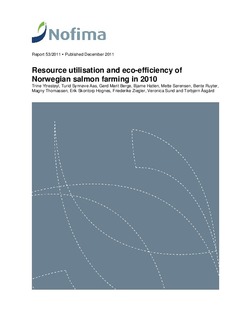| dc.contributor.author | Ytrestøyl, Trine | |
| dc.contributor.author | Aas, Turid Synnøve | |
| dc.contributor.author | Berge, Gerd Marit | |
| dc.contributor.author | Hatlen, Bjarne | |
| dc.contributor.author | Sørensen, Mette | |
| dc.contributor.author | Ruyter, Bente | |
| dc.contributor.author | Thomassen, Magny S. | |
| dc.contributor.author | Hognes, Erik Skontorp | |
| dc.contributor.author | Ziegler, Friederike | |
| dc.contributor.author | Sund, Veronica | |
| dc.contributor.author | Åsgård, Torbjørn Einar | |
| dc.date.accessioned | 2018-10-16T13:27:23Z | |
| dc.date.available | 2018-10-16T13:27:23Z | |
| dc.date.created | 2014-10-07T12:58:37Z | |
| dc.date.issued | 2011 | |
| dc.identifier.isbn | 978-82-7251-946-8 | |
| dc.identifier.uri | http://hdl.handle.net/11250/2568314 | |
| dc.description.abstract | This report consists of four parts: Part 1 is an evaluation of some of the methods used for evaluating food productions in a sustainability perspective. Part 2 is a description of some sustainability indicators often used to evaluate aquaculture productions (Fish in-Fish out ratio, marine protein dependency ratio, forage fish dependency ratio). Part 3 is a resource budget for the Norwegian salmon production in 2010 showing the flow of major nutrients from feed to the different parts of the salmon product. The retention of protein, fat, energy, phosphorus and the essential ω 3 fatty acids EPA and DHA, is calculated both for the edible part and for the whole body of salmon. Alternative usage of the marine feed ingredients is also discussed. Part 4 is an LCA of the 2010 salmon production for the impact factors agricultural land occupation, cumulative energy use, global warming potential and marine primary productivity. The salmon production in 2010 is compared to Swedish pig and chicken production. Possible future dietary scenarios in salmon farming are also evaluated; diets were fish meal and oil is replaced with plant ingredients and animal by-products are compared with the 2010 diet and with a diet with a high level of marine ingredients. | |
| dc.description.abstract | Resource utilisation and eco-efficiency of Norwegian salmon farming in 2010 | |
| dc.language.iso | eng | nb_NO |
| dc.publisher | Nofima AS | nb_NO |
| dc.relation.ispartof | Nofima rapportserie | |
| dc.relation.ispartofseries | Nofima rapportserie; | |
| dc.relation.uri | https://nofimaas.sharepoint.com/sites/public/_layouts/15/guestaccess.aspx?guestaccesstoken=AH6gm4EYCywblasfl0be6GykitTW2EGiRvQ7mXc3nC8%3d&docid=04e3fbed732b94fb7946210821645a0ca | |
| dc.rights | Attribution-NonCommercial-NoDerivatives 4.0 Internasjonal | * |
| dc.rights.uri | http://creativecommons.org/licenses/by-nc-nd/4.0/deed.no | * |
| dc.title | Resource utilisation and eco-efficiency of Norwegian salmon farming in 2010 | nb_NO |
| dc.title.alternative | Resource utilisation and eco-efficiency of Norwegian salmon farming in 2010 | nb_NO |
| dc.type | Research report | nb_NO |
| dc.description.version | publishedVersion | |
| dc.source.pagenumber | 95 | nb_NO |
| dc.source.issue | 53/2011 | nb_NO |
| dc.identifier.cristin | 1161982 | |
| dc.relation.project | Fiskeri- og havbruksnæringens forskningsfond: 900568 | nb_NO |
| dc.relation.project | Nofima AS: 21111 | nb_NO |
| cristin.unitcode | 192,10,1,0 | |
| cristin.unitname | Institutt for husdyr- og akvakulturvitenskap | |
| cristin.ispublished | true | |
| cristin.fulltext | original | |

